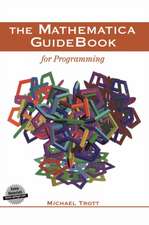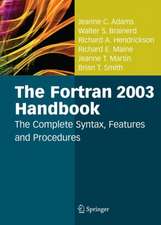Oberon-2 Programming with Windows
Autor Jörg R. Mühlbacher, Bernhard Leisch, Brian Kirk, Ulrich Kreuzederen Limba Engleză Mixed media product – 20 iun 1997
Preț: 595.29 lei
Preț vechi: 744.11 lei
-20% Nou
Puncte Express: 893
Preț estimativ în valută:
113.91€ • 118.93$ • 94.27£
113.91€ • 118.93$ • 94.27£
Carte tipărită la comandă
Livrare economică 04-18 aprilie
Preluare comenzi: 021 569.72.76
Specificații
ISBN-13: 9783540625223
ISBN-10: 3540625224
Pagini: 384
Ilustrații: IX, 372 p. With CD-ROM.
Dimensiuni: 155 x 235 x 20 mm
Greutate: 0.6 kg
Ediția:1997
Editura: Springer Berlin, Heidelberg
Colecția Springer
Locul publicării:Berlin, Heidelberg, Germany
ISBN-10: 3540625224
Pagini: 384
Ilustrații: IX, 372 p. With CD-ROM.
Dimensiuni: 155 x 235 x 20 mm
Greutate: 0.6 kg
Ediția:1997
Editura: Springer Berlin, Heidelberg
Colecția Springer
Locul publicării:Berlin, Heidelberg, Germany
Public țintă
Professional/practitionerCuprins
1. Introduction.- 2. First Steps.- 2.1 Installation of POW!.- 2.2 Operating the system.- 2.3 A first program.- 3. The Working Environment of POW!.- 3.1 Basic ideas.- 3.2 Editor.- 3.3 Project management.- 3.4 Templates.- 3.5 Button bar.- 3.6 Configuration.- 3.7 Working with windows.- 3.8 Tools.- 3.9 On-line help.- 3.10 Menu functions.- 3.11 Typical errors.- 3.12 Advanced topics.- 4. Introduction to Oberon-2.- 4.1 Introduction.- 4.2 Basics of a language.- 4.3 Basic language elements.- 4.4 Oberon-2 programs under POW!.- 4.5 Declarations.- 4.6 Statements.- 4.7 Expressions and assignments.- 4.8 Selection.- 4.9 Repeated execution (Iteration).- 4.10 Structured data types.- 4.11 Procedures.- 4.12 Modules.- 4.13 Pointer types.- 4.14 Recursion.- 4.15 Exercises.- 5. Object-Oriented Programming.- 5.1 Introduction.- 5.2 From abstract data types to classes.- 5.3 Concepts.- 5.4 Design.- 5.5 Application Examples.- 5.6 An object-oriented project.- 5.7 Retrospective and summary.- 5.8 Exercises.- 6. Oberon Portable Applications Library.- 6.1 What is a library?.- 6.2 Overview of the modules.- 6.3 Notes on the Windows implementation.- 6.4 The module ColorPlane.- 6.5 The module Display.- 6.6 The module File.- 6.7 The module Float.- 6.8 The module In.- 6.9 The module Out.- 6.10 The module Param.- 6.11 The module Print.- 6.12 The module Process.- 6.13 The module Strings.- 6.14 The module Utils.- 6.15 The module Volume.- 6.16 The module XYplane.- 7. Programming with the Windows API.- 7.1 Overview.- 7.2 Language extensions.- 7.3 Interfaces to “foreign” DLLs.- 7.4 Basic Windows program.- 7.5 The Mini-resource compiler.- Appendix A: Oberon-2 for Pascal programmers.- A.1 Constants.- A.2 Operators.- A.3 Data types.- A.4 Arrays.- A.5 Strings.- A.6 Open Arrays.- A.7 Pointer types.- A.8 Memorymanagement.- A.9 Compound data types.- A.10 Extensions of record types.- A.11 Procedure types.- A.12 Control structures.- A.13 Procedures.- A.14 Type-bound procedures.- A.15 Modules.- A.16 Export of identifiers.- A.17 Programs in Oberon-2.- A.18 Object-oriented programming.- Appendix B: The Programming Language Oberon-2.- B.1 Introduction.- B.2 Syntax.- B.3 Vocabulary and Representation.- B.4 Declarations and scope rules.- B.5 Constant declarations.- B.6 Type declarations.- B.7 Variable declarations.- B.8 Expressions.- B.9 Statements.- B.10 Procedure declarations.- B.11 Modules.- B.12 Definition of terms.- B.13 Syntax of Oberon-2.- B.14 The module SYSTEM.- B.15 Windows related language extensions.- Appendix C: Table of ASCII Codes.- Literature.
Textul de pe ultima copertă
This book is a detailed introduction to programming in Oberon-2, the object-oriented successor of Pascal. Oberon-2 provides elegant support for programming using a unique blend of structured and object-oriented techniques. The book follows a hands-on approach to teaching based on many examples, starting with basic Oberon-2 language features and gradually increasing in scope to cover the full range of object-oriented programming.
The book is completely self-contained and enables readers to develop native Windows programs. It comes with a multi-media CD-ROM (suitable for Windows 3.1x, Windows 95, and Windows NT 4.0) containing a full Windows-based integrated development environment, all the examples from the book, and a video tutorial to give users an easy start. The included software can be used and distributed freely.
The book is completely self-contained and enables readers to develop native Windows programs. It comes with a multi-media CD-ROM (suitable for Windows 3.1x, Windows 95, and Windows NT 4.0) containing a full Windows-based integrated development environment, all the examples from the book, and a video tutorial to give users an easy start. The included software can be used and distributed freely.






